Yongin, Gyeonggi-do, South Korea – Friday, June 10th, 2011
Everland is South Korea’s largest theme park, both in scale and in attendance. In 2011 it ranked as the 12th most visited theme park in the world by TEA/AECOM (5th in Asia), and for much of the previous decade it even outranked parks such as Universal’s Islands of Adventure. Putting aside any issues with methodology one may have, when I read those statistics and take them at face value, I’m alternately struck by a sense of both inevitability and surprise.
The inevitability comes from the fact that Everland is the only large theme park resort located just outside of the country’s largest city. Its closest competitor, Lotte World, does pretty well too, especially with the advantage of being directly inside the city of Seoul, but the compact indoor nature probably limits that park’s upper capacity threshold relative to Everland. The park is owned by a subsidiary of Samsung, Korea’s largest corporation, so clearly it has good financial support to do whatever it wants. Plus, South Korea’s demographics are well-suited to supporting a successful theme park, being a rapidly developing, industrialized nation with a relatively large and prospering middle class. But even more than any other Asian country I visited, I was struck by how South Korea’s culture also seemed to strongly support the social value of visiting theme parks. I wrote previously about the longer hours that Korean theme parks keep relative to their Asian counterparts, but it really does seem to stem from a natural demand. Once again Everland felt lively in a way that I hadn’t yet experienced in Asia; there was clearly
but the compact indoor nature probably limits that park’s upper capacity threshold relative to Everland. The park is owned by a subsidiary of Samsung, Korea’s largest corporation, so clearly it has good financial support to do whatever it wants. Plus, South Korea’s demographics are well-suited to supporting a successful theme park, being a rapidly developing, industrialized nation with a relatively large and prospering middle class. But even more than any other Asian country I visited, I was struck by how South Korea’s culture also seemed to strongly support the social value of visiting theme parks. I wrote previously about the longer hours that Korean theme parks keep relative to their Asian counterparts, but it really does seem to stem from a natural demand. Once again Everland felt lively in a way that I hadn’t yet experienced in Asia; there was clearly a dedicated local audience that actively makes use of the park as an all-day place to socialize with their family or friend groups. Why Universal or another major international operator hasn’t opened up shop in Korea is somewhat surprising.1
a dedicated local audience that actively makes use of the park as an all-day place to socialize with their family or friend groups. Why Universal or another major international operator hasn’t opened up shop in Korea is somewhat surprising.1
Which leads to the feeling of surprise that somehow Everland is one of the top theme parks in the world. It just… doesn’t feel like a high-profile global theme park? There is exactly one large, marquee roller coaster, and… not much else. It’s big. There’s a large zoo area, a large kid’s area, a large water park, and a large number of rides, but most of them are a basic collection of flat rides, low-tier production model coasters, and a couple of Disney copies. All par for the course for an Asian amusement park. Even Lotte World generally has a much more interesting mix of attractions. Apart from the marquee coaster, there’s virtually nothing at Everland that I would bother riding a second time. Likewise, theming is a bit of mixed bag. To be sure there are some nice areas, but often it skews a little too busy or flamboyant, or are frequently interspersed with areas that don’t appear to have had a refresh since the 1980’s. The park tries for a global theme, but only gets halfway there, with large generic European and American theme zones, a “Global Fair” entry area that’s also largely European kitsch, an undercooked safari area, and a fantasy kid’s area that also appears somewhat Europeanized. Not exactly a well-balanced theme.
generally has a much more interesting mix of attractions. Apart from the marquee coaster, there’s virtually nothing at Everland that I would bother riding a second time. Likewise, theming is a bit of mixed bag. To be sure there are some nice areas, but often it skews a little too busy or flamboyant, or are frequently interspersed with areas that don’t appear to have had a refresh since the 1980’s. The park tries for a global theme, but only gets halfway there, with large generic European and American theme zones, a “Global Fair” entry area that’s also largely European kitsch, an undercooked safari area, and a fantasy kid’s area that also appears somewhat Europeanized. Not exactly a well-balanced theme.
Overall, there’s a lot there, but very little there there.
But still, there is one big thing there. One thing that makes a visit to Everland well worth your time if you’re visiting Korea.
T Express is the last and largest of the four Intamin prefab wooden coasters built throughout the 2000’s, after Colossos, Balder, and El Toro. At 5,383.8 feet long, it was also the fifth longest wooden coaster in the world as of 2011 (although it’s crept up to the #3 spot as of this writing, due to the RMC conversion of two other former record holders).
T Express also rated as the #1 best wooden coaster in the world the year it opened in 2008 for the Mitch Hawker Roller Coaster Poll, and consistently placed in the #2 or #3 position for the next several years until the poll stopped being issued. Certainly the discourse around the ride I saw online during the couple of years between the time it opened and my visit treated it as unquestionably one of the world’s best rides. Which, you know, sets certain expectations.
T Express is named after its sponsor, T World, a Korean telecom company. The modern corporate branding isn’t a particularly good match for the ride’s Swiss alpine theme.
To my pleasant surprise, I discovered that T Express was being run with two trains, and efficiently enough that there was rarely any stacking on the final brakes. With 36 riders able to fit into a single train, despite being a fairly busy day I’d rarely have to wait more than 15 minutes for a ride, with the ride going to near walk-on status by mid-afternoon. Having spent so much time frustrated by poor operations at many Asian parks that left only enough time to ride their star attractions once or twice over an entire day, I finally had a stroke of luck with a world class coaster that I could ride as many times as I pleased. That fact alone already made my day at Everland one of the more enjoyable days I’d have at a park during my travels in Asia.
T Express was designed to be a combination of Six Flags Great Adventure’s El Toro in the first half, and Liseberg’s Balder in the second half, using a hillside setting to its advantage.
Like El Toro, T Express uses a cable lift to quickly and quietly ascend its 183 foot hill. Intamin really liked putting some unnecessarily sophisticated technology on their rides in the mid-2000’s; it’s an odd quirk of coaster history that many rides built today still feel somewhat less advanced than those built over a decade ago, even if they’re more reliable and do everything they need to do.
The thing that Intamin prefab wooden coasters do really well, frankly better than even the RMC creations that would follow in the subsequent decade(s), is doing very steep drops with sharp airtime hills, particularly with its very long 36 passenger trains that create some very strong dynamics at either extremity. The 150 foot first drop isn’t quite as big as El Toro or Colossos, but it’s actually a degree steeper than the New Jersey counterpart.
Likewise, the following camelback hill feels very familiar to fans of El Toro, slightly smaller but it also has good placement atop the hill. Plus, with the banked turn angling sharply away at the bottom, as you crest the hill it almost appears as if the track simply disappears before you.
After that it goes straight into El Toro’s “twister” section buried deep within the supports, with a fast-paced right turn transitioning smoothly (and much more slowly than El Toro) into a left turn. Then it rises up and somewhat awkwardly slams on the brakes.
I can’t think of another major coaster that places its midcourse block brake this early, relative to the total length of the layout. On most large Intamin and B&M coasters the block brake usually comes around the 50%-75% mark within the main layout (seemingly migrating later in the course in recent years), but on T Express it seemingly happens around the 25% mark. After this sudden pause the ride drop down and completely shifts gears into the much longer and more sedate Balder mode.
From this point its a very long, leisurely ride around a figure eight configuration, with shallow banked fan curves separating one or two small airtime hills.
These airtime hills have a somewhat unusual profile. Long, shallow curved valleys in between, then peaking in a very sudden, brief “pop” at the top.
It repeats this formula several times, which does have the effect of creating a bit of disorientation as it becomes hard to tell exactly where in the layout you are.
 There’s not much of a finale except for a couple ground-level curves that break the repetitive pattern.
There’s not much of a finale except for a couple ground-level curves that break the repetitive pattern.
So how do I rate T Express?
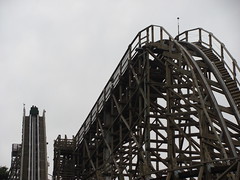 It’s perfectly fine. El Toro is vastly superior. I don’t know how this ride came near the top of the polls. The problem with mixing together El Toro and Balder in a single coaster is… you’re mixing El Toro with Balder, when you could have just gotten straight El Toro. Why don’t you mix together a bottle of Cristal champagne with a carton of Minute Maid orange while you’re at it? Sure, you’ve got a pretty good mimosa, but you could have had a glass of Cristal instead.2 Granted, I’ve never been on Balder, but ever since it debuted and won a bunch of enthusiast acclaim I had always been scratching my head watching the videos trying to figure out what everyone else saw it in. Lots of boring, slow rampy bits with random pops of fairly brief airtime, on a wooden coaster that tries to act like a steel coaster, which defeats all the fun of a
It’s perfectly fine. El Toro is vastly superior. I don’t know how this ride came near the top of the polls. The problem with mixing together El Toro and Balder in a single coaster is… you’re mixing El Toro with Balder, when you could have just gotten straight El Toro. Why don’t you mix together a bottle of Cristal champagne with a carton of Minute Maid orange while you’re at it? Sure, you’ve got a pretty good mimosa, but you could have had a glass of Cristal instead.2 Granted, I’ve never been on Balder, but ever since it debuted and won a bunch of enthusiast acclaim I had always been scratching my head watching the videos trying to figure out what everyone else saw it in. Lots of boring, slow rampy bits with random pops of fairly brief airtime, on a wooden coaster that tries to act like a steel coaster, which defeats all the fun of a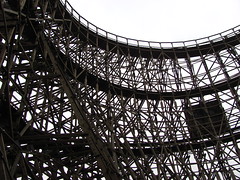 wooden coaster. Assuming T Express’ latter half is a faithful recreation of Balder’s qualities, that section didn’t come close to winning me over to finally understand the hidden genius of Balder that others rave about.
wooden coaster. Assuming T Express’ latter half is a faithful recreation of Balder’s qualities, that section didn’t come close to winning me over to finally understand the hidden genius of Balder that others rave about.
El Toro takes the technology and does something balls-to-the-wall insane with it, but by giving less than half of an El Toro in the first act, it misses all of that ride’s best qualities. The first drop and camelback hill of T Express is by far the highlight of the entire ride, but it lacks both the power and repetition that makes El Toro such an awesome experience. With only a single hill, it’s more like an opening trick than a core part of the ride’s repertoire. The curves that follow don’t even come close to El Toro’s twister section, with none of the snap or rapid-fire pacing. I recall closing my eyes on that section during one of my rides, and the sensations were muted to the point that I couldn’t tell what was going on if I didn’t already know it. Then there’s the awkward block brake that happens way too early in the ride, and the remainder feels dropped in from a completely different planet. I like coasters that have a strong A-B sequence like that, starting as one thing then switching to another. The Raven does it, even El Toro does it. But the two halves have to actually make sense placed against one another; T Express just feels like two rides from different planets randomly got fused together midway through. The whole is not more than the sum of its parts.
feels dropped in from a completely different planet. I like coasters that have a strong A-B sequence like that, starting as one thing then switching to another. The Raven does it, even El Toro does it. But the two halves have to actually make sense placed against one another; T Express just feels like two rides from different planets randomly got fused together midway through. The whole is not more than the sum of its parts.
Still, there are some very strong positives to like about T Express. The Swiss theme is very cute and clever in places without being overbearing, and the hillside setting adds some drama to the presentation. The El Toro-inspired first section is still very good, even if it’s not quite El Toro levels of good. And it does have one quality that El Toro doesn’t have… duration. 5,383 feet is a very long ride by any standard, and while it doesn’t use that full length to maximum effect, I do enjoy that you get to immerse yourself in the experience and it’s not in a hurry to get back to the station too soon. And of course it’s smooth, making it a good coaster to re-ride throughout the day.
While I probably spent close to a third of my time at T Express, I did have to make sure I explored the rest of the park as well. The European Adventure theme zone around T Express also contains this regal garden area along with a handful of other rides.
The two genders…
Mystery Mansion is the park’s shooting dark ride, given a generic haunted house theme, partially supplied by Spirit Halloween.
One unique feature were the ride vehicles, which seat riders in an outward facing ring.
The largest dark ride in the park was Global Village, Everland’s obligatory “It’s a Small World” copy.
On the plus side, the ride doesn’t try to be a direct rip-off of Disney’s Small World, but takes the basic concept of a tour around the world with singing animatronic children and comes up with its own unique ideas for particular scenes.
This more original approach leads to some rather amusing results.
Other parts are more creepy.
It appears as though Global Village takes a slightly more literal-minded approach to the art direction, in some cases just presenting realistic copies of local landmarks.
The United States, represented by football, the most annoying parts of New York City, and… imperialism? Sure, why be subtle about it?
Oh boy, get ready for some racisms…
Now moving through Asia. All told Global Village probably was still the most interesting ride I’d do today, apart from T Express.
“See You Again!” Err, actually, no, we won’t. Five years after my visit in 2016, Global Village was torn down and replaced with a kid’s playground area. As we’ll see, this seems to be part of a trend with Everland.
The Magic Land children’s area is divided into two areas. First, this rather unthemed area with a collection of outdated rides, beginning with the park’s oldest coaster, a powered Zamperla Dragon coaster.
How this ride continues to survive in the park all the way to the time as I write this, while so much else has been torn down, is baffling.
A Ferris Wheel, which I didn’t ride to get photos from for one reason or another. I’m guessing it was a combination of the wait and the heavily tinted windows that would have frustrated any photographic attempts.
And a Flume Ride, which appeared incredibly soaking. This attraction has since been replaced by a slightly larger, more modern flume called Thunder Falls.
The other area within Magic Land is called Aesop’s Village. While for kids, this was easily the best environment of the park, one of the few places where Everland actually felt like a major theme park. Aesop’s Village opened in 2005 with design by Toronto-based Forrec.
However, there was only one attraction in here of interest to me. Herky & Timmy’s Racing Coaster is a somewhat confusing name that suggests a more elaborate backstory, possibly tied to the tortoise and the hare fable.
While not a racing coaster as the name would suggest, this Vekoma junior coaster still has some unique qualities, featuring a custom design that uses the terrain and landscaping to its advantage. Recall that Disney also has a few compact production model Vekoma junior coasters, and Herky & Timmy holds up quite nicely in comparison.
Next, moving into the American Adventure theme zone. Like Magic Land, this zone is divided into a couple different areas, beginning with this more frontier styled side at the base of a hill.
Columbus Adventure is the park’s massive, dueling swinging ship ride. The theme is a little all over the place with its wild western-style entry leading to a ships belonging to the cancelled Italian explorer, but I couldn’t skip a swing ride this impressively oversized, especially with no wait.
Undoubtedly the biggest disappointment of the day was that the park’s Arrow suspended coaster Eagle Fortress was still closed indefinitely.
That same coaster poll that rated T Express in the top three among wood coasters also consistently rated Eagle Fortress in a similar position for best steel coaster in the world, an extremely impressive feat for Everland to capture both categories. (Especially given the general lack of quality everywhere else.)
Eagle Fortress was built in 1992 on the side of a hill, with a high-speed layout skimming very close to both the ground and the dense foliage, almost like a suspended version of Boulder Dash. The experience appeared incredible from all the videos I’ve seen, and virtually impossible to re-create today. If I had to choose between only getting to ride Eagle Fortress or T Express, I would have picked Eagle Fortress, no questions.
But it was never meant to be. Eagle Fortress closed in late 2008, just several months after T Express had opened. While talking to a friendly ride host at T Express earlier that day, he mentioned the logic was that Eagle Fortress was an older ride whose time had come once this better, newer ride was ready to replace. (I kept my composure upon hearing that. Please remember to only scream inside your heart.) At the time the rumor was the park was looking to modify Eagle Fortress, possibly with floorless seats, especially as the less than 20 year ride presumably still had more service life left in it, compared to the age of other Arrow suspended coasters. I held out hope that might come to pass before my visit, but it appeared increasingly unlikely the closer my travel date approached.
That rumor persisted for a couple years after my visit, but by 2015 the entire structure was ultimately torn down. The next rumor was possibly another large custom steel coaster that may follow some of the path established by Eagle Fortress, similar in nature to Verbolten’s replacement of The Big Bad Wolf at Busch Gardens Williamsburg. However, as of 2020 any such replacement plans haven’t materialized, and the only thing occupying the map where Eagle Fortress once stood is a plum blossom garden trail. Easily the biggest and most pointless loss for coaster fans in Asia from the past decade-plus.
With no Eagle Fortress, all I could do was move on to the rest of the American Adventure section, in an area called Rocksville.
Rocksville is a sort of bizarre collision between 1950’s nostalgia and a late-80’s/90’s neon Po-Mo style, like if Jack Rabbit Slim’s from Pulp Fiction was an entire city block. This area contains a few of the park’s more thrilling flat rides.
It also contains the park’s only other large coaster apart from T Express, Rolling X-Train.
This Arrow Dynamics looping coaster opened in 1988. Two loops, two corkscrews, a helix… pretty basic.
Unlike Eagle Fortress, Rolling X-Train had been lucky enough to receive some upgrades that kept it from getting torn down. New trains were added in 2004, although they failed to significantly improve the ride experience.
Several sections of track also appeared to have been redesigned and replaced in recent years, which did make for a much smoother ride experience. Clearly Arrow Dynamics did not know how to make that advanced of a banked curve back in the late 80’s.
I got to ride it once, managing to nab a front row position. It was a fine if forgettable experience.
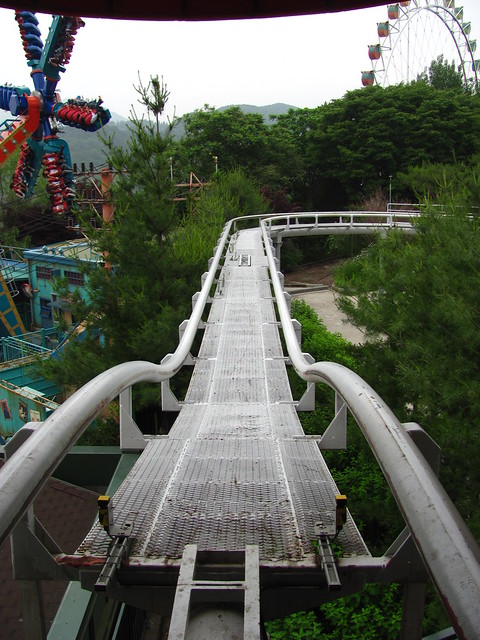 (But clearly the wrong choice of Arrow coaster for the park to reinvest in.)
(But clearly the wrong choice of Arrow coaster for the park to reinvest in.)
The most interesting aspect may have been in the queue, filled with references to classic American roller coasters, including a full layout plan for the Long Beach Cyclone Racer.
As the day wore on I spent more of my time over at T Express. However, by late afternoon the decision was made to remove one of the two trains. Somewhat frustrating, but I already had a decent number of laps in. The the queue now backing up, I made my way to explore the final Zoo-Topia theme section. While “Zoo-Topia” might sound like a blatant copyright infringement, it had actually been named that since long before Disney made a movie of the same name. The big attraction here is Safari World, a drive-around safari attraction featuring African animal exhibits.
The vehicles were… something to behold. Not quite as charming as Hayao Miyazaki’s catbus.
There’s a few of the large herbivores you can find at nearly any zoo, like giraffes, zebras, and a lone elephant.
The majority of the tour is spent with their large predators, like lions, tigers, and bears. Some of whom can walk right up to the tiger-bus.
There was even a single liger!
Honestly the tour was somewhat depressing, with most of the animals forced to sleep or roam in close proximity to the roving tiger-vans as their enclosures offered few other places for them to go. For the humans as well, it missed the feeling of a safari, and was just watching a bunch of animals from the windows of a moving vehicle. More traditional zoological walk-through exhibits may have made both humans and animals happier.
Less ethically questionable was the Amazon Express, a river rapids ride.
Waiting to do the water rides towards the end of the day has the advantage that most of the queues have completely cleared out. Plus, on this particular ride you got to hide beneath a large plastic canvas to keep from getting wet. Sure, I’ll take it! Beats handing over 2,000 won for a disposable rain poncho.
With the sun now set, I opted to spend my final hour in the park re-riding T Express as much as I could with the one train operation.
The crowds had started to filter out, and by the very end of the night the ride was once again a walk-on.
 Overall it felt both surprising and inevitable that I’d consider my day at Everland one of my more enjoyable of my Korean trip. Surprising because, as I detailed in this report, nearly every aspect of the park was a disappointment in one way or another. Yet it was inevitable because, in the case of T Express, it was only disappointing from the perspective of not being one of the best wooden coasters in the world. Given that I gave myself an entire day at a park with a still very good coaster that rarely saw a 15 minute queue, I was able to stop stressing and simply enjoy my time at the park according to my own preferred flow and schedule. It’s a very different mindset when I can ride simply for my own immediate pleasure and not out of a sense of having to check it all off a list before it closes or breaks down, nor have to worry about keeping a schedule and
Overall it felt both surprising and inevitable that I’d consider my day at Everland one of my more enjoyable of my Korean trip. Surprising because, as I detailed in this report, nearly every aspect of the park was a disappointment in one way or another. Yet it was inevitable because, in the case of T Express, it was only disappointing from the perspective of not being one of the best wooden coasters in the world. Given that I gave myself an entire day at a park with a still very good coaster that rarely saw a 15 minute queue, I was able to stop stressing and simply enjoy my time at the park according to my own preferred flow and schedule. It’s a very different mindset when I can ride simply for my own immediate pleasure and not out of a sense of having to check it all off a list before it closes or breaks down, nor have to worry about keeping a schedule and simply run out the day’s clock until the park closes.
simply run out the day’s clock until the park closes.
However, if I were to rate all four Seoul-area parks in terms of likeliness to return should I ever find myself in Seoul again, Everland would probably rank last. It’s for the simple reason that, even after a full decade, there’s still nothing new that I would particularly want to return for, and the park is far enough from the city to require a full day commitment that isn’t worth it for more rides on T Express alone. Maybe someday Everland will build something else good that reminds us this park is still inexplicably one of the most popular theme parks in the world. Although, given past trends, who knows if T Express would survive for long after that day.
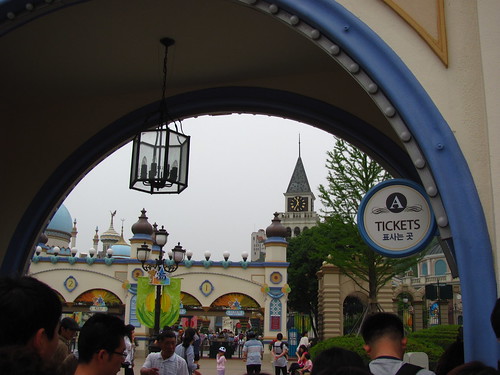
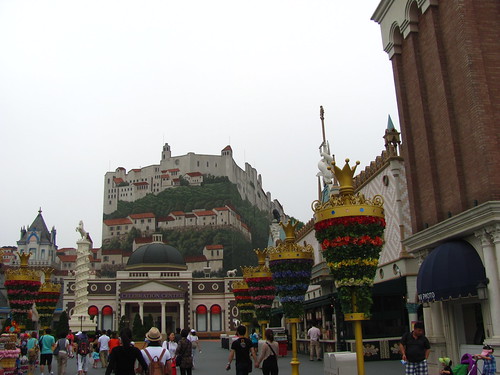



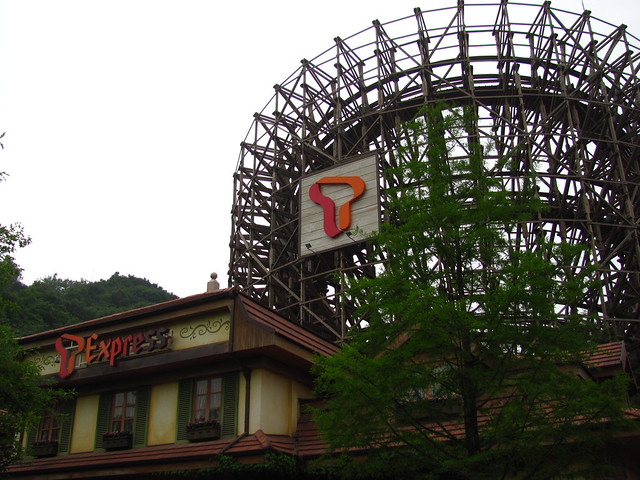
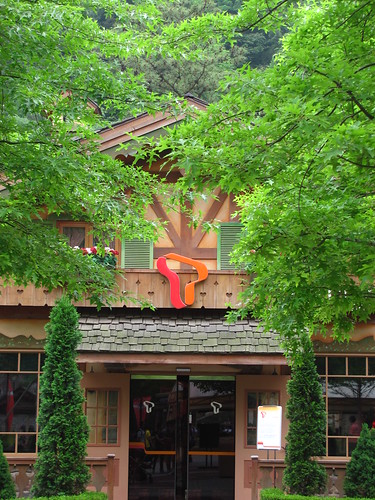





















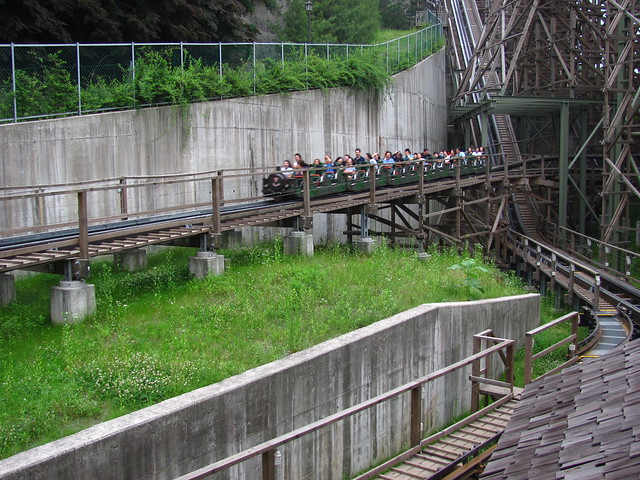


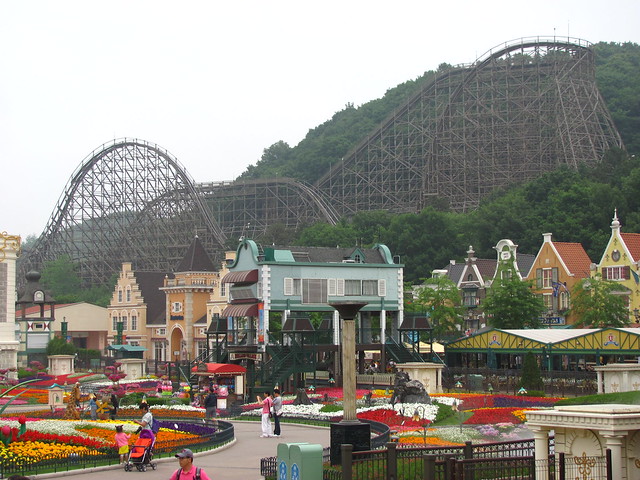


















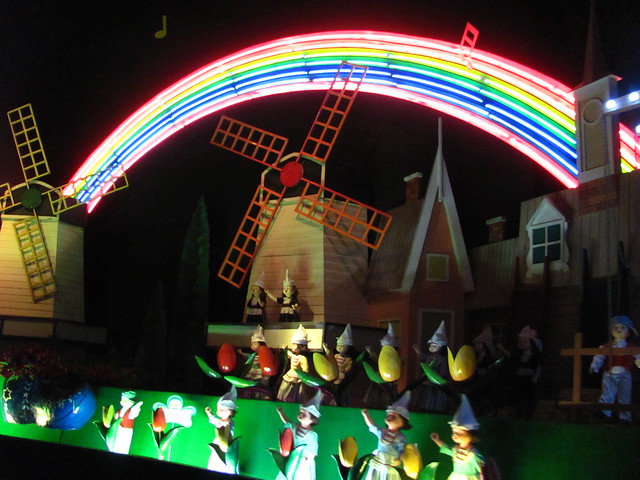

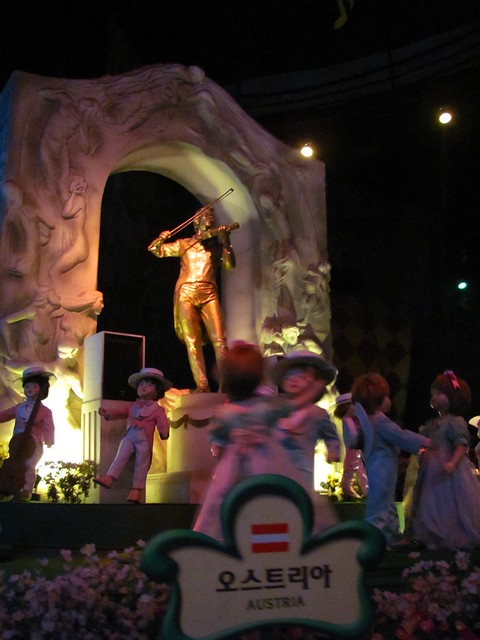










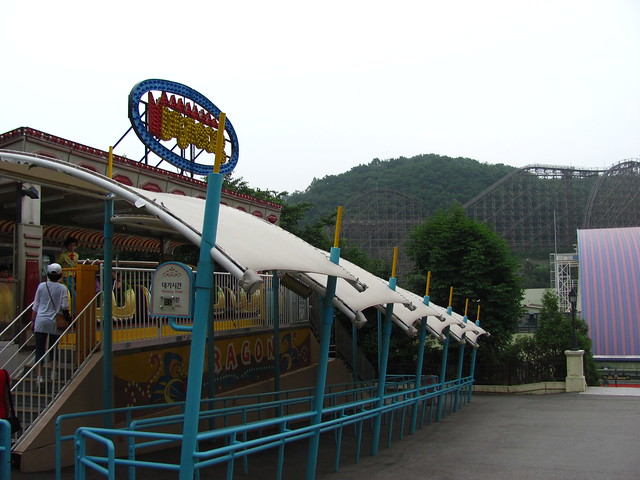


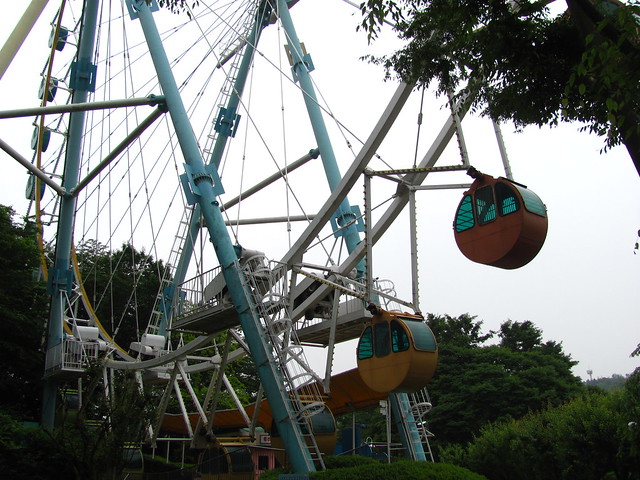
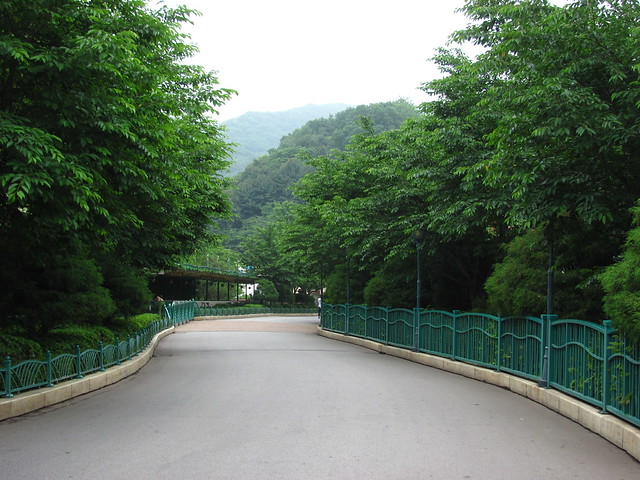


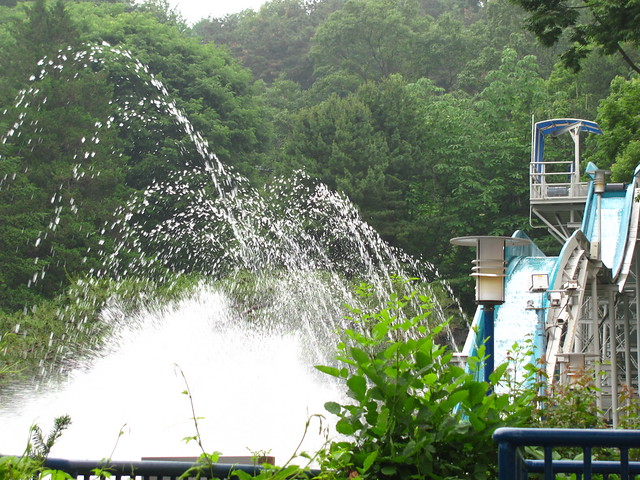




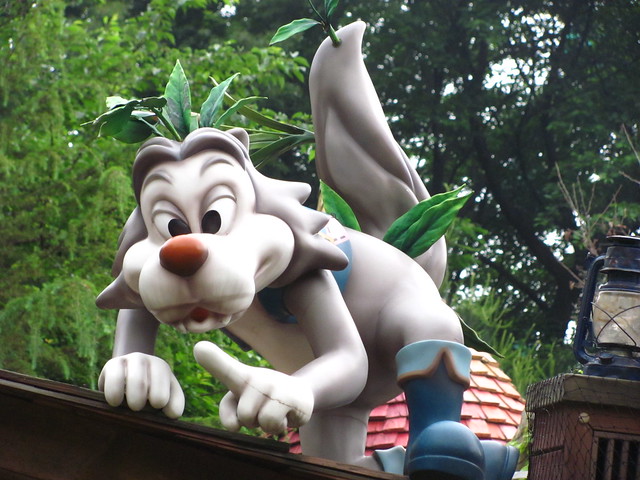
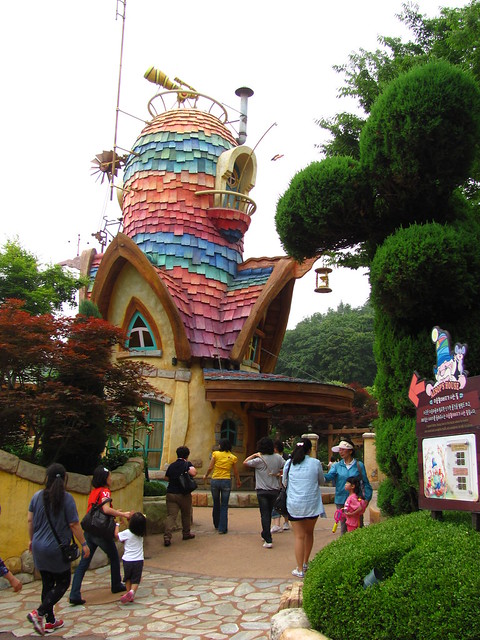



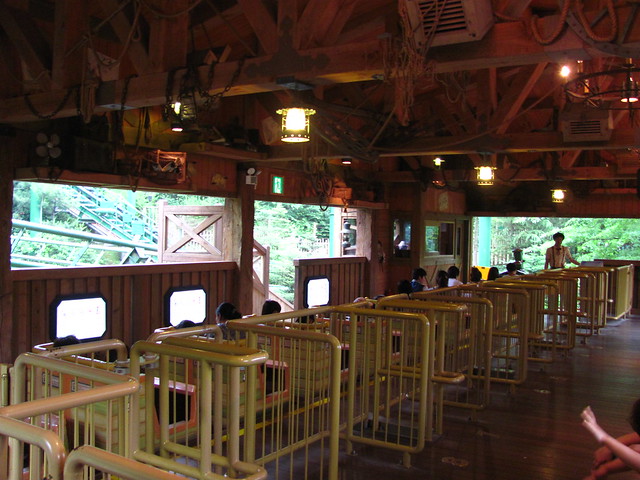

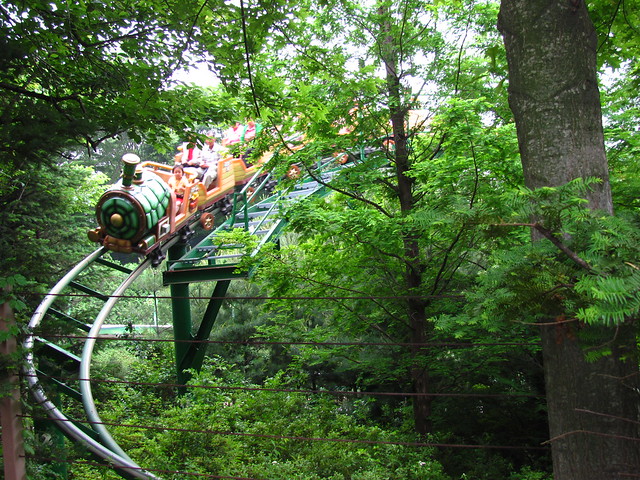














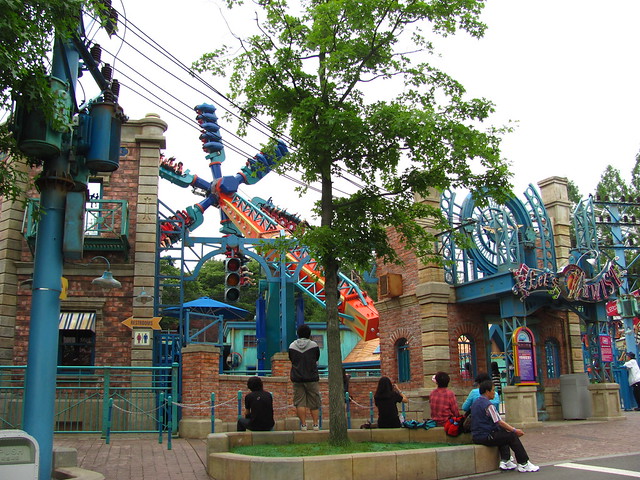

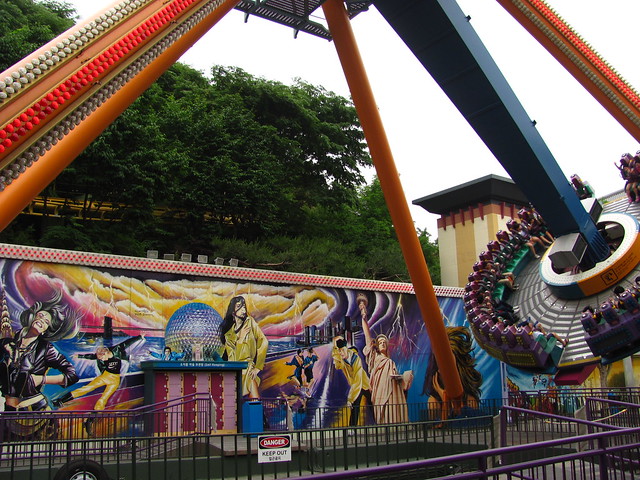



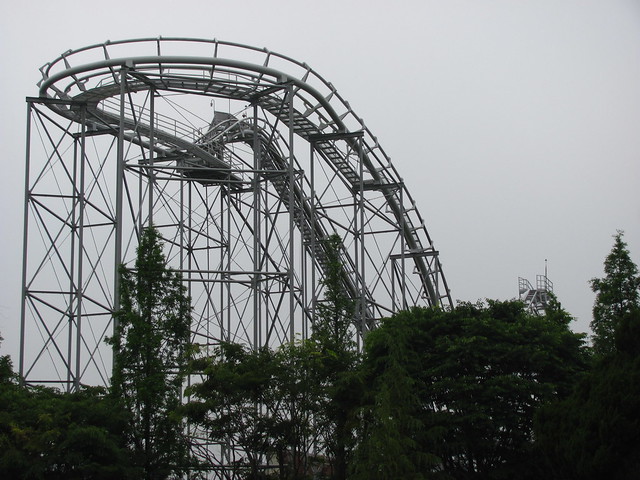
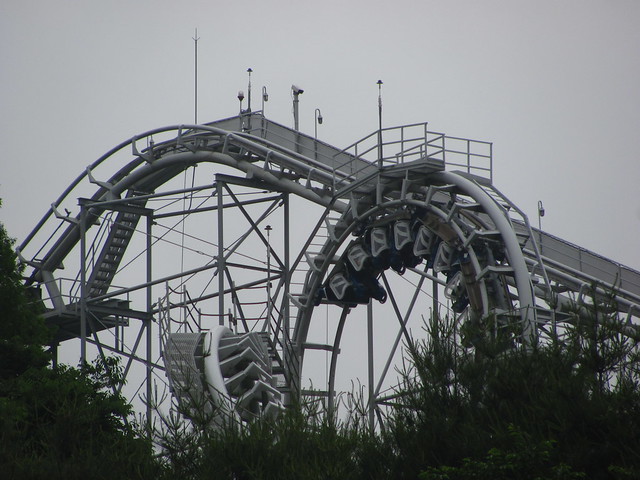
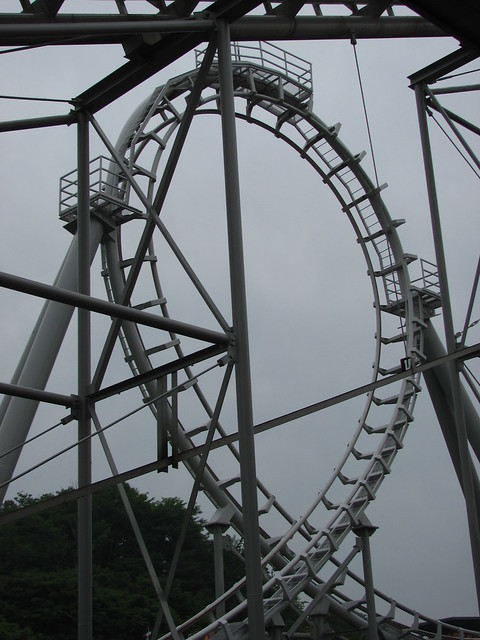

















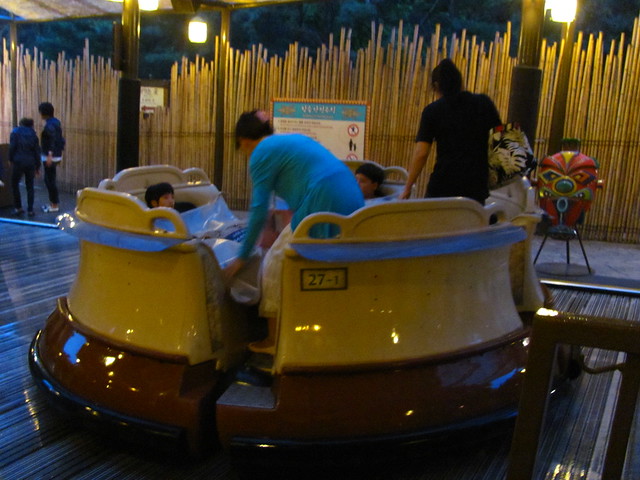









Comments